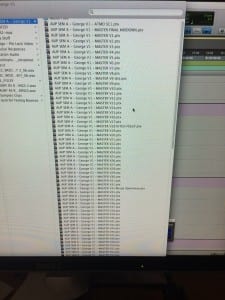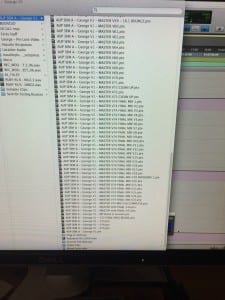A solidly dull topic for a research blog this but pretty useful to the general cause of managing five post on five films.
We should receive picture lock for our final three films by the end of this week, and we’ve been working post on the two we already have rough cuts for a couple of weeks prior to this. With multiple people now working simultaneously in different environments, we’re just getting to the point where things can potentially get complicated in terms of versioning and data management, which I thought was worthy of a look over to see if our process can be made fitter.
At present, the only nod towards sensible data management we operate (I say we, really I operate it and people tend to follow my lead in the matter because I tend to get in first and set the basic sessions up) is a basic versioning of session files and semi-regular backups of our work in two places. This isn’t very effective, and our semester A project’s main folder ended up looking like this –
It’s pretty straightforward though, V15 is four versions later than v11, and I add extra detail where appropriate like ‘SC3 Foley Work’ for example. This is just about workable when we’re a small group working largely on one system with the only external work being that of importing occasional files like comped music tracks into the pre-existing session, but is going to need improving as we’re now working on multiple assets for the same film simultaneously in different places.
A quick google search brings up some advice on simple changes that can be made, which is actually aimed at software app makers but is applicable here –
My current system definitely means files suffers from being indistinguishable from one another, especially since I tend to put the V number at the end of the filename, where it’s always helpfully cut off by the Mac finder dialogue in load screens which leaves me reliant on the system’s date ordering and the presumption the top file is latest in the list.
“…Strong naming conventions are essential in order to maintain an efficient pipeline,” (Production Pipeline Fundamentals for Film and Games, 193)
Digging a little deeper into more specific literature for audio project management (actually referring to the even more data-complex games industry) I found the following key concepts to help me hit some of the aims above, demonstrated on George version 1.1 below.
- Seperation of name elements – So, georgev11foleyfinal becomes george_v11_foley_final
- Consistent use of capitals – george_v11_foley_final becomes George_V11_Foley_FINAL
- Better structuring of sections for listing purposes – George_V11_Foley_FINAL becomes V11_George_Foley_FINAL
- Better use of the numerics (add 0’s) – V11_George_Foley_FINAL becomes 01-1_George_Foley_FINAL
- More consistent and specific descriptives – 01-1_George_Foley_FINAL becomes 01-1_George_Foley_COMPLETE
I will be adopting this regimen for Descent as it’s post-production begins, and all our groups’ films should have a designated central machine upon which all the audio and session data is regularly consolidated which would sensibly be the machine upon which the film is going to be mixed. it will then be up to the mixer and supervisor to manage any incoming data from anybody working on the film elsewhere such as music files and sessions or editing sessions, and I would suggest the regimen here is augmented with something like an x01-1_George_Dialogue_EDIT_GB filename to differentiate work that is taking place elsewhere from the ‘master’ files.
This thinking about process will also naturally lead on to discussion of our system of backups, and I think it’s prudent and will be suggesting that supervisors for each film get into the habit of backing up the main version of their work at least every couple of days when post-work is in regular progress. [GR1 + PER1]
—– 650Words
KEY POINTS –
Research into more sensible file-naming regimen and better data management – Research.
Outcomes –
- [GR1] To professionally operate as a small to medium size company (or other recognisable business entity) in the audio production / post-production field might.
- [PER1] To develop a better understanding of the pros and cons of business structures, processes and agreements which might enable film audio producers to collaborate on multiple projects


